| British Rail Class 35 | |||||||||||||||||||||||||||||||||||||||||
|---|---|---|---|---|---|---|---|---|---|---|---|---|---|---|---|---|---|---|---|---|---|---|---|---|---|---|---|---|---|---|---|---|---|---|---|---|---|---|---|---|---|
 D7030 at Reading in 1971 | |||||||||||||||||||||||||||||||||||||||||
| |||||||||||||||||||||||||||||||||||||||||
| |||||||||||||||||||||||||||||||||||||||||
| |||||||||||||||||||||||||||||||||||||||||
| |||||||||||||||||||||||||||||||||||||||||
The British Rail Class 35 is a class of mixed-traffic B-B diesel locomotive with hydraulic transmission. Because of their Mekydro-design hydraulic transmission units, the locomotives became known as the Hymeks. They were numbered D7000-D7100.[3]
The class was developed for the Western Region of British Railways, which had opted for lightweight locomotives with hydraulic transmission, when allocated funds under the British Railways Modernisation Plan of 1955. 101 of the class were built between 1961 and 1964, when it became apparent that there was a requirement for a medium-power diesel-hydraulic design for both secondary passenger work and freight duties.
They were allocated to Bristol Bath Road, Cardiff Canton, and Old Oak Common. None of the class was named. Withdrawal from service began in 1971, and was completed by 1975. Their early withdrawal was caused, primarily, by BR classifying the hydraulic transmission as non-standard.
Development
The builder, Beyer Peacock (Hymek) Ltd, was a joint venture between Bristol Siddeley Engines (BSE) (licensed to build Maybach engines), Stone-Platt Industries (licensed to build Mekydro transmissions), and the locomotive manufacturer Beyer, Peacock and Company. At the time they were built, the Hymeks were the most powerful diesel-hydraulic locomotives operating with a single engine – the Maybach MD870. Unlike the higher-powered diesel-hydraulic Class 42 and Class 43 (Warship classes), and Western locomotives in the Western Region fleet (with dual Maybach MD655 engines), the Hymeks were not based on an existing West German design but one developed by the industrial design consultants, Wilkes and Ashmore.[4]
Operational service
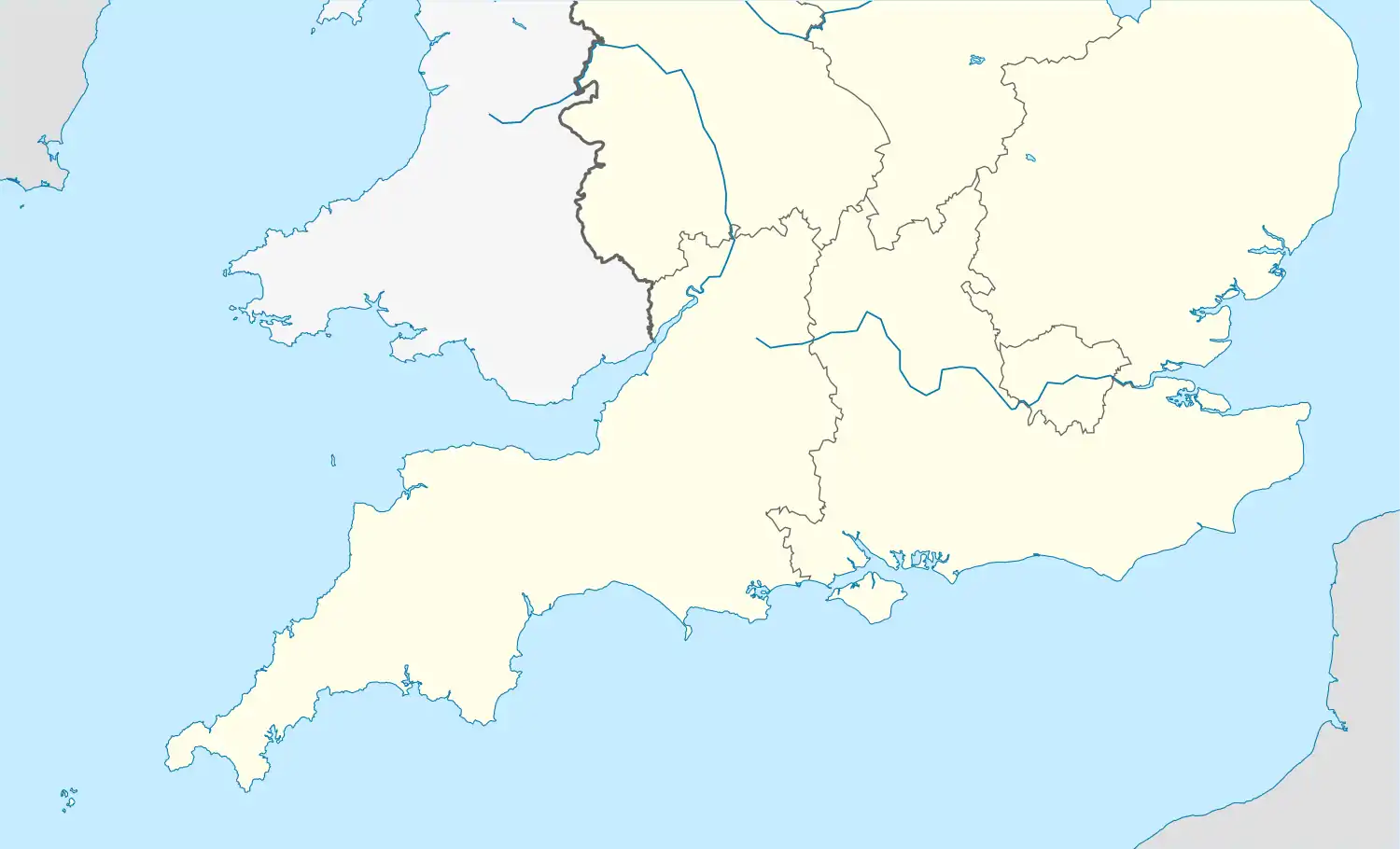 81A 82A 83A 84A 86A | ||
| Code | Name | Quantity |
|---|---|---|
| 81A | Old Oak Common | 23 |
| 82A | Bristol Bath Road | 40 |
| 83A | Newton Abbot | 1 |
| 84A | Laira | 1 |
| 86A | Cardiff Canton | 36 |
| Total: | 101 | |
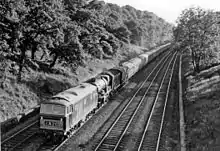
The original intention was for the Hymeks to replace steam locomotives in the Bristol area, west of Newton Abbot, and in South Wales, taking parcels and freight services within each area, and also passenger services to and from London.[6] On introduction in 1961 the first locomotives were employed on secondary passenger services based around Bristol, such as Paddington to Hereford and semi-fast services to the west of England and Wales. Once they had proved themselves more than capable of handling these duties, they were also assigned to express Paddington-Cardiff-Swansea services, displacing King-class steam locomotives. These duties were heavier than they were designed for, and the Hymeks were displaced when Western and Brush type 4 locomotives became available to allow accelerated timings.
Hymeks also worked pickup freights throughout the Western Region as a mixed-traffic design and were used heavily on inter-regional passenger services. This latter often caused operational problems as they would often terminate in areas where there were no trained staff to handle the locomotive once the rostered crew had 'booked-off'. To avoid these instances, the locomotive would invariably be dispatched back to the nearest Western Region tracks without delay. The Hymeks were capable of operating in multiple, but only with each other. The electro-pneumatic control system (coded "Yellow Triangle") allowed only one trailing locomotive to be controlled (by one driver): some trains were operated by three locomotives (all at the front of the train), but in these cases only two locomotives were connected in multiple, the third having a separate driver.
Hymeks were used all over the Western Region on mixed traffic services from secondary passenger and parcels through express freight to ballast trains. They were common in all parts of the region from Paddington to Bristol/South Wales/Worcester/Hereford. They also worked to Birmingham and the West of England, but were rare west of Plymouth.
Hymeks were notably used as bankers on the Lickey Incline, propelling mainly freight trains from Bromsgrove to Blackwell. During trials, it was discovered that the Hymeks changed between first and second gear at about the speed required to bank a train up the incline, and so they tended to "hunt" between the two gears. Repeated gear changes under full power caused excessive wear and damage, plus excessive heat in the transmission fluid quickly resulted in the locomotive stopping. The simplest way to avoid excessive wear, and the stopping of a train on the incline, was to lock first gear out of action, via the master switch located in each locomotive's A-end cab.[7] With all Lickey bankers allocated to Worcester shed, the main group of five locomotives (D7021 - D7025) and any replacements were all turned on the Worcester triangle, so that the A-cab was always aligned up the incline. Once at the bottom of the incline, each train which required banking would be signalled to the banking locomotives by Gloucester Panel Signal Box, so that the banking crew could then determine if it was necessary to lock out first gear on one or more of the locomotives.[8] These banking operations commenced in 1969 and involved one, two or three locomotives with two locos set up to work in multiple plus an additional single locomotive (three in total) in operation on any given day. Particularly heavy trains such as the Llanwern to Immingham steel train required all three locomotives.[9]
Accidents and incidents
- On 13 July 1969, locomotive No. D7048 was involved in an accident at Spetchley, Worcestershire.[10]
- On 15 December 1971, a Cardiff to Portsmouth Harbour train hauled by D7013 collided with Southern Region 4-CIG electrical multiple unit no. 7303 on the high level section of Portsmouth And Southsea station, Hampshire. Sixteen passengers and railway staff were injured.[11] The accident report notes that "...the locomotive suffered a badly bent buffer and other cab-end damage as well as minor underframe distortion...". D7013 was withdrawn from service on 1 January 1972.[12]
Liveries
When first built, the Hymeks were given a more elaborate livery than many of the contemporary British Railways diesel classes. The main body of the locomotive was the standard dark Brunswick green, but with a lime green stripe along the bottom of the bodywork. The roof was medium grey, and the finishing touch was to paint the window surrounds in ivory white. In the early 1960s, yellow warning panels were added to the lower part of the front ends, in accordance with BR's then-new policy. With the advent of the Corporate Identity scheme in 1965[13] some locomotives received all-over BR Rail Blue with small yellow warning panels. This was quickly changed by the return of off-white window surrounds. The final variation was BR blue with full yellow ends, the yellow being extended around the cab side windows.
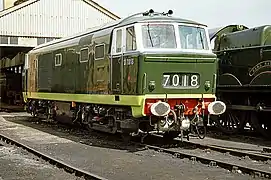 Green, no warning panel.
Green, no warning panel.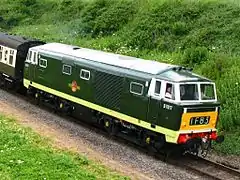 Green, small panel.
Green, small panel.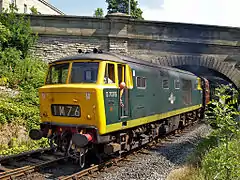 Green, full warning panel.
Green, full warning panel.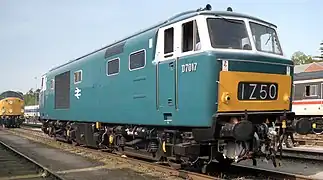 Blue, small warning panel.
Blue, small warning panel.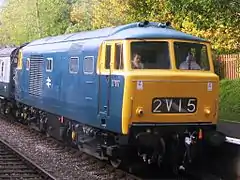 Blue, full warning panel.
Blue, full warning panel.
Withdrawal

The aim of the Modernisation Plan had been to stem BR's financial losses. These were thought to arise partially from the labour-intensive nature of steam locomotive use. The rapid introduction of diesel and electric traction eliminated steam from mainline use by 1968, but many unsuitable designs of diesel locomotive had been rushed into service in order to achieve this. The National Traction Plan of 1967/8 decreed that designs proving unreliable, expensive to maintain or non-standard should be eliminated as quickly as possible in order to reduce the number of diesel classes from 28 to 15 by the year 1974. The engineering factions of the British Railways Board, the body that oversaw BR's operations from 1962 onwards, felt that all of the Western Region's diesel-hydraulic fleet should be counted as non-standard and should be withdrawn as quickly as possible. This was driven in part by the introduction of Mark 2D air-conditioned carriages, which could only be heated electrically. This requirement for electric train supply (ETS) placed all diesel-hydraulic locomotives at a disadvantage compared with diesel-electrics. The entire class was withdrawn between 1971 and 1975. They were replaced by Class 37 diesel-electric locomotives made redundant in other regions as a result of a general decline in railborne freight traffic throughout the 1960s.
Formal withdrawal was not the end for three locomotives: 7076 and 7096 continued to be officially in non-revenue stock for some years and 7089 also continued, but renumbered as TDB968005 in the Departmental series.
Preservation
Four locomotives have been preserved.
| Pre TOPS |
Owner | Location | Status | Notes or livery |
|---|---|---|---|---|
| D7017 | Diesel & Electric Preservation Group (DEPG) | West Somerset Railway | Non-operational[14] | BR Green with half yellow warning panel. |
| D7018 | Diesel & Electric Preservation Group (DEPG) | West Somerset Railway | Non-operational[14] | BR Green with half yellow warning panel. |
| D7029 | Diesel Traction Group (DTG) | Severn Valley Railway | Undergoing Restoration[15] | BR Blue yellow warning panel. |
| D7076 | Bury Hydraulic Group (BHG) | East Lancashire Railway | Operational[16] | BR Blue yellow warning panel. |
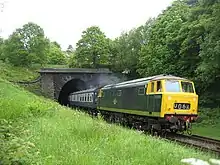
Notes:
- D7017 and D7018 have been fully restored to working order since withdrawal. D7018 was returned to service in June 2019 following an extensive overhaul.[17] As of June 2022, D7018 was stabled at Williton railway station.[18] On 9 May 2009, D7017 successfully hauled a 350-ton test train on the WSR, after a four-year overhaul.[19] Both locomotives are painted in BR Green with yellow warning panels.
- D7029 - Severn Valley Railway
- D7029 is still undergoing a major restoration. In 2005 it moved from Old Oak Common shed, in west London, to the Severn Valley Railway for further work.[15]
- D7076 - East Lancashire Railway
- D7076 survived, along with sister locomotive D7096, at the Railway Technical Centre near Derby, where they were used as dead loads for research purposes. Warship no. D832 Onslaught was additionally present at this site. Both Hymeks were in poor condition; however, it proved possible to rebuild one by using the other as a donor locomotive. D7076 was therefore restored using parts from D7096 and carries the number D7096 internally in one driving cab as a nod to the donor locomotive, which was reduced to a shell and subsequently scrapped.
- Having been restored to working order, and used on service trains, D7076 was taken out of traffic in late 2008 for repairs to a leaking turbo and coolant faults. The engine was subsequently found to need a complete rebuild, so in an unusual move, a Maybach MD-655 engine from D1041 (Western Prince, stopped for overhaul) was fitted into the locomotive to make it a runner. The resulting loco was nicknamed a "WesMek". However, late 2009 / early 2010 D7076 was taken out of traffic due to the Maybach MD-655 engine developing a liner seal problem. During summer 2011, two ex-Hymek MD-870 engines were discovered in a scrapyard in York, in excellent condition, having been used in a hospital emergency generator set. Both engines were purchased by D7076's owning group, and one has been fitted into D7076, which returned to service at the ELR's July 2011 diesel gala. The other engine is to be retained as a spare. On 11 November 2013 work started on bodywork repairs at Castlecroft Diesel Depot. In July 2014 D7076 returned to service on the East Lancs Railway in BR Blue Livery with full Yellow ends.
Model railways
In 1966, Hornby Railways launched its first version of the BR Class 35 (Hymek) in OO gauge.[20]
In 1970, Tri-ang added a Hymek to their 0 gauge battery-powered 'Big Big Train' toy series. This was made in two self-coloured plastic bodies, neither matching actual locomotive liveries. One was in the blue and white electric locomotive livery, lighter in colour than Rail Blue and labelled on the body sides as 'Blue Flier', then another in bright yellow.[21] Mark 2 passenger coaches were also available in a set with it. The Big Big Train range only lasted a few years, from 1966 to 1972.
Hornby had released models of "Bear", listed as "D7101", for their Thomas and Friends range. The first batch of models were released in 2005, and were discontinued in 2010. In 2012, the character was briefly re-released into the same range.
References
- ↑ "Maybach MD870". sp9010.ncry.org.
- ↑ "Section 4 - Technical". Hymek.
- ↑ "Beyer-Peacock 35 B-B". BRDatabase.
- ↑ Moss, Paul (2000). Underground Movement. London: Capital Transport. p. 128. ISBN 185414-226-7.
- ↑ British Rail Locoshed Book. Shepperton: Ian Allan. February 1968. p. 29. ISBN 0-7110-0004-2.
- ↑ "The Hymek Type 3 diesel locomotive for the Western Region". Trains Illustrated. Vol. XIV, no. 154. Hampton Court: Ian Allan. July 1961. pp. 436–437.
- ↑ Lewis, JK, "The Western's Hydraulics", ISBN 978-1-901945-54-6
- ↑ "Hymek Class 35 Diesel Hydraulic at Worcester History Beyer Peacock Mayback".
- ↑ "Motive power miscellany". Railway World. Vol. 30, no. 345. Shepperton: Ian Allan. February 1969. p. 93.
- ↑ Hoole, Ken (1982). Trains in Trouble: Vol. 3. Redruth: Atlantic Books. p. 47. ISBN 0-906899-05-2.
- ↑ "MOT_Portsmouth1971" (PDF). Jonroma.net.
- ↑ "D7013". BRDatabase.
- ↑ "British Rail Corporate Identity". www.doublearrow.co.uk.
- 1 2 "DEPG Locomotive Status". The Diesel and Electric Preservation Group. October 2023.
- 1 2 Kerr, Fred (2022). Western Region Diesel Hydraulic Locomotives in Preservation. Pen and Sword Books. p. 54. ISBN 9781399013406.
- ↑ "ELR:DG Website - D7076 Status". East Lancashire Railway Diesel Group Website. October 2023.
- ↑ "D7018 due to return - a quarter of a century later". West Somerset Railway. 14 June 2019. Retrieved 9 August 2019.
- ↑ "Monthly Archives". The Diesel and Electric Preservation Group. June 2022. Retrieved 26 June 2022.
- ↑ "Diesel delight..." West Somerset Railway. 9 May 2011. Retrieved 9 August 2019.
- ↑ "Hornby BR Class 35 (Type 3) Hymek". Hornby Railways Collector Guide. Retrieved 1 February 2020.
- ↑ "Sizing up the Small Small range of Tri-ang Big Big trains". Collectors Club of Great Britain. 3 April 2019.
Bibliography
- Reed, Brian (1974). Diesel-Hydraulic Locomotives of the Western Region. Newton Abbot: David and Charles. ISBN 0-7153-6769-2.
- Williams, Alan; Percival, David (1977). British Railways Locomotives and Multiple Units including Preserved Locomotives 1977. Shepperton: Ian Allan Ltd. ISBN 0-7110-0751-9.
- McManus, Michael. Ultimate Allocations, British Railways Locomotives 1948–1968. Wirral. Michael McManus.
- Clough, David N. (2011). Hydraulic vs Electric: The battle for the BR diesel fleet. Ian Allan. ISBN 978-0-7110-3550-8.
- Marsden, Colin J.; Fenn, Graham B. (1988). British Rail Main Line Diesel Locomotives. Sparkford: Haynes. pp. 142–145. ISBN 9780860933182. OCLC 17916362.
- Vehicle Diagram Book No. 100 for Main Line Diesel Locomotives (PDF). Derby: British Railways Board. October 1984. p. 91 (per pdf).
{{cite book}}:|work=ignored (help) - "Outlines of Power No. 9: Class 35". Rail Enthusiast. EMAP National Publications. December 1983. pp. 32–33. ISSN 0262-561X. OCLC 49957965.
- Kerr, Fred (December 1983). "The 'Hymeks'". Rail Enthusiast. EMAP National Publications. pp. 51–55. ISSN 0262-561X. OCLC 49957965.